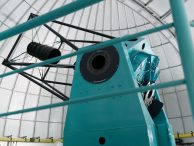From 2023, the Vera C. Rubin Observatory will carry out a vast mapping of the Universe: the « Legacy Survey of Space and Time » (LSST). In order to minimize the undesirable effects of the atmosphere on the images, the observatory has been testing testing since February a holographic system installed on its auxiliary telescope. With this very innovative device, designed by the IJCLab, the improvement of the measurements from the main telescope could be equivalent to that expected with a telescope twice as large.
The Rubin Observatory currently under construction in Chile, on the Cerro Pachon mountain, will make it possible to observe the sky at an unprecedented depth. Its technical characteristics will enable to detect an enormous quantity of distant objects and to deepen our knowledge of the Universe in particular by measuring the physical quantities associated with dark energy with an excellent precision.
As for any telescope on Earth, the atmosphere acts as a filter that alters the light coming from stars and galaxies. It is therefore necessary to measure this absorption in order to correct the fluxes received by the telescope and to recover the fluxes above the atmosphere. At the Rubin Observatory, this task is performed by the auxiliary telescope. This telescope, equipped with a spectrometer, will compare from the ground in real time the spectra of standard stars with their out-of-atmosphere spectra, known thanks to space observatories such as Hubble or GAIA.
A hologram to combine the focus and the dispersion
The dispersing element of the spectrometer initially planned, whose function is to decompose the colors of the stars as a prism would, had the disadvantage of producing blurred images in the red and infrared regions of the spectrum. This is why a team from the Irène Joliot Curie Laboratory of Physics of the 2 Infinities (IJCLab) proposed to use a hologram. The technique of holography, especially known for its capacity to restore the vision in 3 dimensions, made it possible to provide at the same time the focusing and the dispersion with a single optical element, which solved the blurring issue.
After a promising test phase, the IJCLab designed the hologram in collaboration with the Laboratory of Nuclear and High Energy Physics (LPNHE) and the Advanced Materials Laboratory of the Lyon Institute of Physics of the 2 Infinities (LMA / IP2I). It is now installed since February 2021 on the auxiliary telescope of the Rubin Observatory and has allowed to extract spectra of much higher quality than those obtained with the initially planned device. Beyond its application to the Rubin Observatory, this first experimentation could lead to a new way to transform very simply an imager into a spectrometer.
More
Legend : Photo of the auxiliary telescope at Rubin Observatory in Chile (May 2020).
Image Vera C. Rubin Observatory Rubin Observatory/NSF/AURA
French article on In2p3 website
Contact : moniez@lal.in2p3.fr

